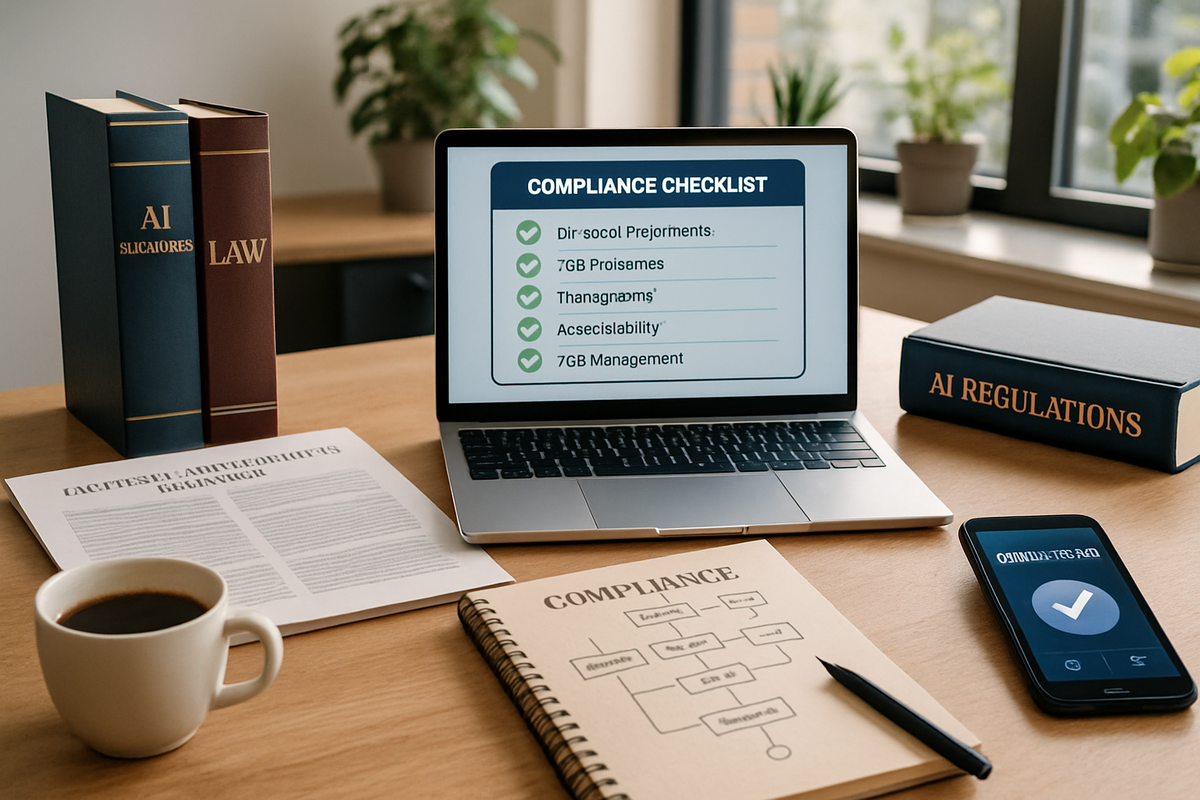AI Compliance Playbook 2025: The Ultimate Guide to Navigating Global AI Regulations (EU, US, China & Beyond)
Navigate the global AI landscape with our essential playbook—your guide to compliance, innovation, and staying ahead in a legally shifting AI world. Don't miss out on turning regulatory challenges into your next strategic advantage.

August 21, 2025 — By Funaix Editorial Team
“In 2025, AI compliance isn’t just a legal checkbox—it’s your passport to global markets, customer trust, and innovation that won’t get handcuffed at the border.”
Why You Need This Playbook—Now
AI regulations have officially gone global, and compliance is no longer a spectator sport. The EU’s AI Act is now enforceable, China’s AI regime is flexing its regulatory muscle, the US is unleashing sectoral rules faster than you can say “algorithmic transparency,” and every other major market is adding its own flavor of AI oversight.
- Confused by risk classes, auditing, and cross-border data? You’re not alone.
- Worried about compliance deadlines? Join the club—so is the rest of the world.
- Need practical steps, not just legalese? Welcome home.
This playbook is designed for business leaders, legal and compliance professionals, CTOs, and product managers who need to get it right, right now. Let’s decode the chaos, one regulation at a time.
Section 1: The Big Three—EU, US, China
1. The EU’s AI Act: The World’s First Comprehensive AI Law
The EU AI Act (Regulation (EU) 2024/1689) entered into force August 1, 2024, and its main provisions for general-purpose and high-risk AI models become enforceable by August 2, 2025. If your AI touches the EU—even by a single byte—this law likely applies to you.
- Scope: Applies to providers, deployers, importers, and distributors of AI systems in the EU, including those outside the EU offering AI services to EU users.
- Risk-Based Approach: AI systems are classified as unacceptable risk (prohibited), high risk (strict requirements), limited risk (transparency), and minimal risk (no specific obligations).
- Key Requirements:
- Risk assessments and conformity checks for high-risk AI
- Transparency obligations (e.g., disclosure of AI-generated content)
- Human oversight and technical robustness
- Data governance and record-keeping
- Registration of high-risk AI in the EU’s public database
- Fines: Up to €35 million or 7% of global annual turnover (whichever is higher) for non-compliance. Yes, that’s not a typo.
Action Checklist:
- Map all AI systems used or offered in the EU.
- Classify each system by risk level.
- Develop documentation and risk assessment protocols.
- Establish human oversight and monitoring processes.
- Prepare for audits and register high-risk systems.
2. United States: Sectoral Patchwork, Big Stakes
The US loves a good regulatory patchwork. There’s no single AI law—yet—but expect:
- Sectoral rules from agencies like the FTC (consumer protection), FDA (medical AI), SEC (financial models), and DOE (energy sector).
- State-level action (California, New York, and others).
- Federal Executive Orders pushing for transparency, fairness, and safety reviews in government procurement and critical sectors.
“If you’re building or using AI in the US, assume that regulators are watching—and that plaintiffs’ lawyers are taking notes.”
Action Checklist:
- Track sector-specific rules for your industry.
- Implement algorithmic impact assessments where required.
- Monitor state-level developments and adapt privacy/data practices accordingly.
3. China: The Fastest-Moving, Most Comprehensive Regime?
China’s AI regulation is a moving target—think deep synthesis rules, algorithmic filing requirements, and ethics reviews. If you serve Chinese users or operate in China, you must:
- Register algorithms with the Cyberspace Administration of China (CAC)
- Comply with content moderation and transparency rules
- Enable user opt-out and algorithmic explainability
- Adhere to strict data localization and cybersecurity requirements
Action Checklist:
- Identify all public-facing algorithms and file with CAC.
- Implement content controls and user notification mechanisms.
- Ensure data storage and transfer meet Chinese legal standards.
Section 2: Other Major Markets
United Kingdom
No single AI law, but a strong focus on pro-innovation regulation and sectoral guidance. The UK’s AI Safety Institute and sectoral regulators are setting the tone for safety, transparency, and human oversight—especially in critical sectors.
Canada, Australia, Brazil, and Beyond
- Canada: Voluntary AI Code of Conduct and sectoral privacy/data laws.
- Australia: Voluntary safety standards and proposals for mandatory guardrails on high-risk AI.
- Brazil: New risk-based AI bill with pre-deployment impact assessments and a focus on anti-discrimination.
Many countries are converging on risk-based, sector-specific oversight—even if their acronyms are as confusing as their coffee orders.
Section 3: Cross-Border Data & AI Auditing—The Global Gotchas
Data Transfers
With data sovereignty and privacy rules tightening, you’ll need to:
- Map all data flows (especially for training and inference)
- Implement transfer mechanisms (SCCs, adequacy, or localization)
- Monitor for new adequacy decisions and bilateral agreements
AI Auditing
Ready for your first AI audit? You should be. Both the EU and China require documentation, record-keeping, and the ability to show your work. US regulators and private litigants are following suit.
Pro Tip: Build AI compliance by design—don’t wait for the knock at your (virtual) door.
Section 4: Your AI Compliance Toolbox
Essential Tools & Practices
- Automated risk assessments: Streamline with compliance software (think OneTrust, TrustArc, or BigID).
- Documentation templates: Create reusable playbooks for audits and regulatory filings.
- AI transparency dashboards: Make it easy for humans (and auditors) to understand your models.
- Training & awareness: Regularly train staff on new obligations—AI compliance is everyone’s job.
Sample AI Compliance Checklist
- Inventory all AI systems and their purposes.
- Classify by risk, geography, and sector.
- Conduct risk and impact assessments.
- Document data sources, training, and testing protocols.
- Implement human oversight and feedback loops.
- Prepare for external audits and regulatory filings.
Section 5: Voices from the Frontlines
“The biggest compliance risk in 2025 is not the unknown, but the unprepared. Those who build compliance into their AI DNA will be the ones who thrive.”
— Global AI Policy Leader, Interviewed for Funaix
Legal experts and AI policy leaders agree: The era of ‘build first, comply later’ is over. The winners? Organizations that treat compliance as a living, breathing practice—not a dusty binder on a shelf.
Section 6: Frequently Asked Questions
Q: What’s the penalty for non-compliance?
A: In the EU, fines can reach up to €35 million or 7% of global revenue. In the US and China, expect regulatory investigations, injunctions, and private lawsuits. Yikes.
Q: Do open-source AI models need to comply?
A: Yes—especially if they’re deployed as part of a product or service in regulated markets.
Q: What about startups?
A: No free passes. Many laws scale requirements based on risk, but even small companies must meet transparency and safety standards. (On the bright side, compliance can be your competitive advantage!)
Section 7: Get Ahead—And Stay Ahead
AI compliance is a journey, not a destination. The rules will keep changing, but so can your playbook. Stay tuned to Funaix for smart news, expert interviews, and actionable checklists delivered straight to your inbox.
Want to join the conversation? Subscribe for free at Funaix Insider—only subscribers can read and write comments. Be part of the smartest compliance community online. (Did we mention it’s free? For now.)
This article is for informational purposes only and does not constitute legal advice. For specific compliance guidance, consult a qualified attorney or regulatory expert.
Copyright © 2025 Funaix. All rights reserved.




